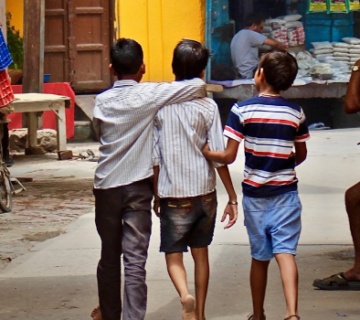The phenomenon of forced migration to Europe remains one of the unresolved issues in the debate between EU countries. Too divided by particular interests to identify a common policy, inspired by the principles of solidarity and sustainability. We talked about it with Pasquale Ferrara, Italian ambassador in Algeria.
According to the UNHCR*, 75,522 migrants landed by sea on the European coasts of Italy, Malta, Cyprus, Spain and Greece from January 1st to October 21st 2019. In addition, 16,322 migrants arrived by land in Greece and Spain for a total of 91,844 people, of which 9,270 in Italy, 2,738 in Malta, 1,183 in Cyprus, 25,191 in Spain, 53,462 in Greece. Data that follow a decreasing trend ( in migration) and documents the emergency phase, but are not enough for Europe to start a broad and constructive dialogue on the subject: the prospect of the creation of a European system of flow management remains very remote, and in general the comparison at the institutional level does not take into account the perspective of African countries. In Algiers we joined the Italian Ambassador, Pasquale Ferrara:
(2ND PART)
It has long been said that it is necessary to formally establish a collaboration with the countries of North Africa, but also with those of transit. Good intentions but few concrete facts…
To move on to concrete facts, we must take note of the reality, of the fact that the African countries, especially those of the North we consider transit countries, which are themselves countries of destination for emigration. Egypt is home to over 200,000 refugees on its territory, while in 2018 just over 120,000 people arrived in the whole of Europe. The few hundred illegal migrants who arrive from Algeria are all Algerians, not sub-Saharan migrants who pass through Algeria, because often these migrants stay here. Moreover, these countries do not accept programs aimed at creating “hotspots” for sub-Saharan migrants. Here the Turkish model does not work, where the European Union has given 6 billion euros to manage camps where more than 4 million Syrian and other refugees are accommodated. The operation worked in Turkey because there was war in Syria and because of Turkey’s strategic interests. In Africa the phenomena are very different and other ways have to be found.
What forms of collaboration could work?
We don’t need asymmetrical collaborations but equal partnerships. We must bear in mind that it is not only we Europeans who have a migration problem, and so it is necessary to respect these countries with their internal needs, including those of migration. Only then can we try together to manage the phenomenon. For example, there are already cooperation agreements between Italy and Algeria dating back to 2000 and 2009 that work well.
What do they include?
The joint management of the migratory phenomenon in terms of the fight against exploitation and trafficking of human beings, the trans-national criminality that uses the phenomenon to finance itself, the danger of terrorist infiltration. There are also provisions for the agreed, orderly and dignified repatriation of illegal migrants.
There is talk that Western countries must support African countries in order to create better living conditions thus discouraging migration. How viable is this?
Under the current conditions of the international economy and political culture, I see it as impractical and, all in all, ineffective. Firstly, we are already talking about a billion Africans: no European or world ‘Marshall Plan’ could address such demographic dimensions. Among other things, Africa is very diverse, there are countries in advanced development conditions: Ghana has a higher rate of technological innovation than several developed countries; Angola is a very resource-rich country that is trying to reorganise its economic structure in a more participatory way. We have leaders, such as the new Nobel Peace Prize winner, the Prime Minister of Ethiopia, Abiy Ahmed Ali, who is 42 years old and looks to the new generations. He has already planted 350 million trees in a worldwide reforestation program called the Trillion Tree Campaign. Uganda is experiencing a period of strong development. The problem is rather the dramatic and unfair economic disparities, and here the West can intervene by helping to improve the governance of these countries, so that it is more inclusive and participatory. But let us remember that these are the same problems of socio-economic polarization that we have in Europe: unfortunately, we cannot give many lessons in this field.
Reflecting on the migratory phenomenon at an institutional level, the economic dimension is at the forefront, while the human dimension is neglected. What does it mean to put human person at the centre of the migratory problem?
Behind every migrant there is a story, a family, a rough journey, the difficulty of obtaining money and perhaps debts with criminal organizations. Of course we cannot allow illegal immigration because everything must be done in accordance with the law, but giving value to the human dimension means taking into account this past and not seeing these people as numbers that arrive on board boats or by land. I was deeply struck by the story of that 14-year-old boy from Mali, found at the bottom of the sea with a school report with excellent marks sewn into his jacket. That is a story that leaves us speechless. And behind it is a family tragedy, a human tragedy, a torn social fabric. I recommend Cristina Cattaneo’s beautiful book, “Shipwrecked without a face. Giving a name to the victims of the Mediterranean”. But let’s not forget also the stories of our Navy – in particular that of the commander Catia Pellegrino – who saved thousands of shipwrecked people. People, faces, real events.
* https://data2.unhcr.org/en/situations/mediterranean
(read part 1 of the interview)
Edited by Claudia Di Lorenzi


 Italiano
Italiano Español
Español Français
Français Português
Português




Un ringraziamento sentito all’editorialista per aver sottoposto ai lettori un tema così importante e ovviamente all’Ambasciatore italiano, per i dati forniti.